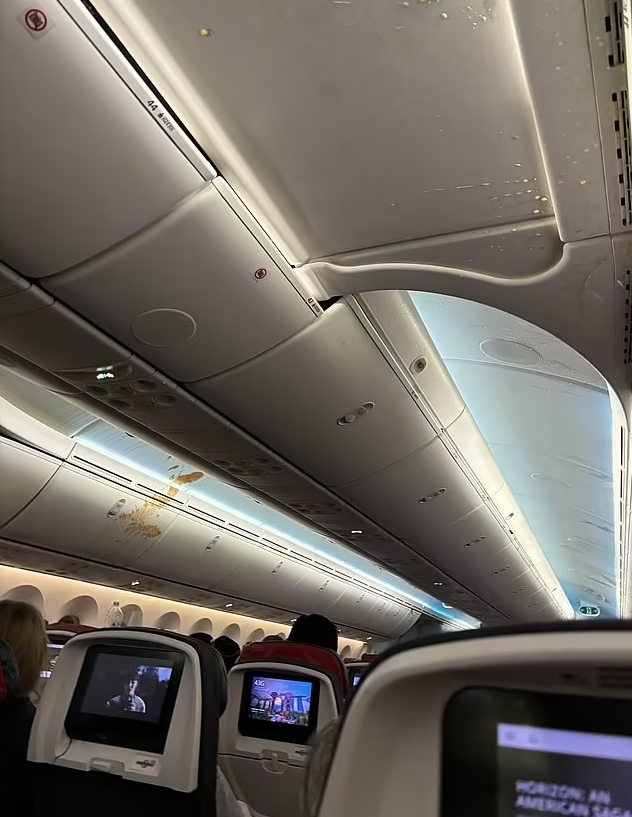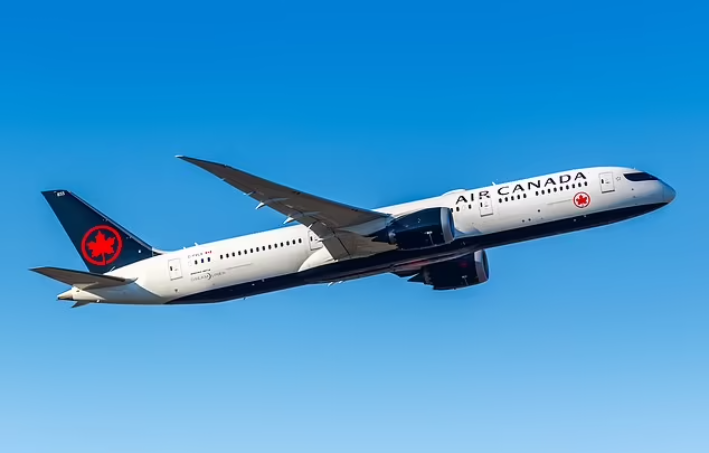Passengers on an Air Canada Boeing 787 experienced a terrifying mid-air ordeal last week when extreme turbulence sent food and beverages flying across the cabin, splattering the ceiling and covering passengers. The chaos unfolded during Flight AC19 from Vancouver to Singapore, leaving many passengers shaken but thankfully unharmed. This incident highlights the growing frequency of severe turbulence in modern aviation and its potential impact on passengers.

The Turbulence Incident: Air Canada Flight AC19 Shaken by Sudden Drops
During Flight AC19’s journey from Vancouver to Singapore, turbulence struck about two hours into the flight, causing the Boeing 787-9 Dreamliner to drop over 6,000 feet in approximately five minutes, according to data from FlightAware. The sudden plunge resulted in a chaotic cabin, with food trays, drinks, and passengers briefly suspended in mid-air. One passenger captured the aftermath, sharing shocking images of the trashed cabin, with food and beverages splattered on the ceiling and seats.
Reddit user Morrell Andrews, who was on the flight, described the unsettling experience: “All you see is heads go up, food and drinks hit the roof.” Another passenger added, “It felt like one of those roller coasters where you have several seconds of weightlessness.” Despite the dramatic scene, all passengers were reported safe, and the flight continued to its destination without further incidents.
A First-Hand Account: Passengers React to the Turbulence
Passengers on board shared their reactions online, recounting the shock and helplessness they felt as the turbulence struck. One passenger admitted, “I was terrified, never had turbulence like that before. It really made me realize how helpless you are on a plane.” Another detailed the moments after the turbulence, saying, “I started cleaning my area like mad while shaking, trying to calm myself and holding back tears.”
Some passengers described the sensation of weightlessness, with one noting that coffee was dripping from the ceiling, and they were “picking rice out of my hair afterward.” Despite the frightening experience, all passengers expressed relief that no injuries occurred. However, it served as a sobering reminder of the unpredictability of air travel.
The Science of Turbulence: What Causes These Sudden Drops?
Airplane turbulence is an everyday occurrence in aviation, but what exactly triggers such severe incidents? Turbulence is essentially irregular air movement caused by various factors, including atmospheric pressure, jet streams, and storms. Pilots typically encounter two main types of turbulence:
1. Clear-Air Turbulence: Occurs at high altitudes and is caused by abrupt changes in wind speed or direction. It’s nearly impossible to detect visually, making it one of the most unpredictable types of turbulence.

2. Turbulence Caused by Clouds: This turbulence occurs when planes pass through low-level clouds, often during takeoff, landing, or when flying through storm systems.
Experts believe that the frequency and severity of turbulence may be increasing due to climate change, with a study showing a 55% rise in severe turbulence incidents from 1979 to 2020. As global temperatures rise, the jet streams become more erratic, creating more frequent and intense turbulence episodes.
Passenger Safety During Turbulence: Why Seatbelts Matter
The extreme turbulence on Air Canada Flight AC19 serves as a critical reminder of the importance of wearing seatbelts at all times during a flight. Passengers often underestimate the need for seatbelts once the plane is in cruising mode, but sudden turbulence can strike without warning, throwing unbuckled passengers from their seats.
In cases of severe turbulence, flight attendants, too, are at risk of injury. In past incidents, flight attendants have been thrown against the cabin ceiling, sustaining serious injuries. For this reason, passengers are urged to keep seatbelts fastened throughout the flight, even when the seatbelt sign is turned off.
Airline Responses: Managing Mid-Air Turbulence
Airlines like Air Canada have protocols in place to manage in-flight turbulence, from keeping passengers informed to instructing crew members on safety measures. During episodes of extreme turbulence, pilots often adjust altitude or change flight paths to minimize the effects. Passengers are advised to remain seated, keep their seatbelts fastened, and store loose items securely.
Airline staff also play a vital role in managing passenger safety during turbulence. They communicate clearly with passengers, ensure that aisles are clear, and swiftly address any medical emergencies that may arise due to falls or injuries.
Recent Incidents: Other Flights Affected by Severe Turbulence
The Air Canada flight is not the only recent example of severe turbulence. Earlier this year, a flight from London to Singapore experienced a sudden drop of 6,000 feet, resulting in one fatality and injuries to 23 passengers. Another flight from Doha to Dublin encountered turbulence during meal service, sending both food and flight attendants flying through the air. Twelve passengers were injured, with eight requiring hospitalization upon landing.

These incidents emphasize the importance of aviation safety measures, especially as climate change continues to contribute to more unpredictable weather patterns. Airlines and pilots are now focusing more on improving turbulence detection systems and providing more detailed turbulence forecasts to ensure passenger safety.
The Future of Turbulence: Can Technology Reduce the Risks?
As turbulence incidents become more frequent, the aviation industry is exploring advanced technology to better predict and manage turbulence. Enhanced radar systems, real-time data sharing between planes, and artificial intelligence-driven forecasts are among the innovations being developed to reduce turbulence-related risks.
In addition to technology, airlines are focusing on pilot training to better handle turbulence and ensure smoother flights. Passengers, meanwhile, are encouraged to stay informed about safety protocols, follow crew instructions, and always keep seatbelts fastened during the flight.
Conclusion: The Reality of Air Travel and Turbulence
The turbulence experienced on Air Canada’s Boeing 787 serves as a stark reminder of the unpredictability of air travel. While modern airplanes are built to withstand extreme turbulence, passengers still face discomfort, fear, and potential injury during such incidents. Maintaining safety awareness, staying prepared, and following airline guidelines can help reduce the risks associated with turbulent flights.
As aviation technology continues to evolve, we may see improvements in turbulence prediction and management. Until then, passengers should always be prepared for unexpected bumps in the air—keeping their seatbelts fastened and items secured.


